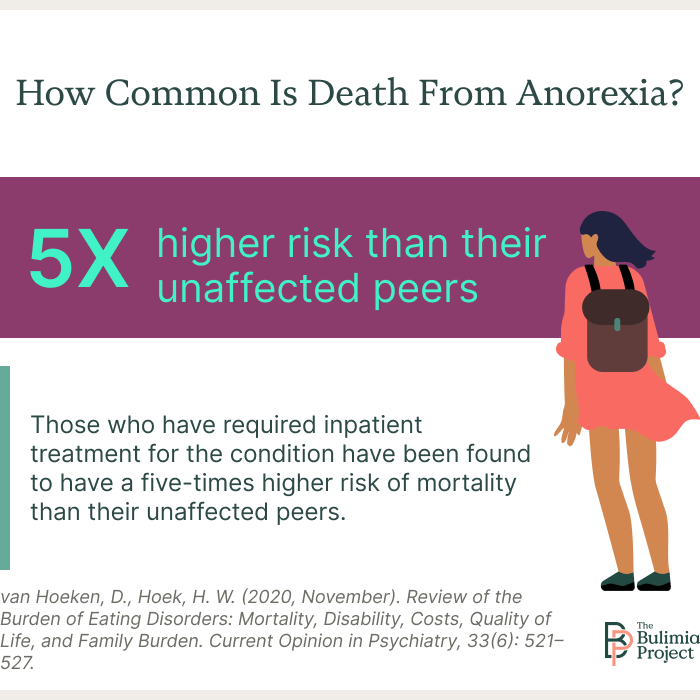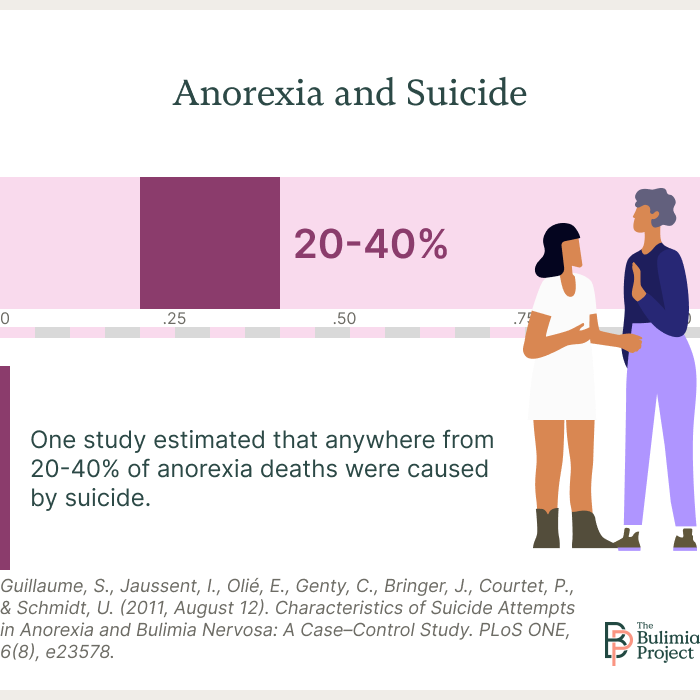As a person continues to struggle with anorexia and the eating disorder progresses, they will grow increasingly malnourished. Unfortunately, this can lead to the body shutting down and dying. Their mental distress may also increase to the point where they may even attempt suicide.
But recovery is possible. The earlier someone seeks treatment, the better their chances of a full recovery.
The Physical Signs of Late-Stage Anorexia
There’s currently no official definition for “late-stage anorexia,” though people who have long struggled with the condition are sometimes described as having “severe and enduring anorexia nervosa.”
Regardless, the condition takes a physical toll after any amount of time. When the body doesn’t receive enough energy and nutrients from food to sustain itself, it will begin breaking down its own tissues and shutting down certain functions to compensate. In addition to common eating disorder symptoms, this could look like:1
- Blotchy or yellow skin
- Dry skin
- Dry mouth
- Extreme sensitivity to cold
- Osteoporosis (thinning of the bones)
- Notable loss of muscle and fat
- Lowered sex drive
- Hair loss
Those who have dealt with anorexia nervosa long-term may be significantly malnourished and exhibit more serious signs of deteriorating health, including:2
- Damage to major organs and organ systems, including cardiovascular, digestive, endocrine, urinary, and excretory
- Abnormal heart rhythms or heart failure
- Difficulty recovering from injuries
- Greater susceptibility to illnesses
- Amenorrhea (lack of menstruation)
- Low heart rate
- Low blood pressure
- Fainting
- Stunted growth in younger people
The Mental Signs of Late-Stage Anorexia
As the lack of vitamins and nutrients continues to impact the body, these deficits increasingly affect the mind.
Someone struggling with long-term anorexia may begin to experience confusion and have serious difficulty thinking clearly or remembering details.
The hormonal fluctuations brought on by malnutrition can also cause mood swings and contribute to additional mental health conditions, like anxiety and depressive disorders.
How Common Is Death From Anorexia?
Unfortunately, the toll anorexia nervosa takes on the body and mind can be fatal if not treated. And the anorexia death rate is significant.
Those who have required inpatient treatment for the condition have been found to have a five times higher risk of mortality than their unaffected peers. And even patients treated outside a hospital have about double the risk of mortality compared to those without eating disorders.3

In fact, anorexia is the deadliest type of eating disorder, and second only to opioid use disorder as the deadliest mental health disorder.4
The high risk of mortality is due to a combination of health complications that result from malnourishment and the increased risk of suicide that has been connected to the various mental health aspects of the condition.
Within Health offers personalized remote eating disorder treatment backed by years of experience.
Within’s IOP and PHP programs offer meal kit deliveries, a numberless scale, a convenient app to attend therapy sessions and view your schedule, and so much more.
Call for a free consultation
Anorexia and Suicide
Indeed, anorexia nervosa has been linked to an increased likelihood of attempted suicide, and the condition has the unfortunate distinction of being the eating disorder with the highest rate of completed suicide.5
One study estimated that anywhere from 20-40% of anorexia deaths were caused by suicide.5
The risk of a successful suicide attempt is greater for people who struggle with AN than for those who experience bulimia nervosa, which also carries a higher risk of attempted suicide compared to those without eating disorders. One study estimated that suicide accounts for 20-40% of anorexia deaths.5

The reason for this difference isn’t fully understood, but researchers have several theories for the connection. Some posit that anorexia leaves the body weaker and more susceptible to the means used for attempted suicide. Others believe the link is more mental health-based, with those struggling with anorexia choosing more serious and lethal options.
Regardless, if you or someone you love is experiencing suicidal thoughts, it’s important to seek help immediately. A resource for people in crisis is the National Suicide Prevention Lifeline, which can be reached at 1-800-273-8255.6 If a person is not in immediate crisis, they should speak with a mental health professional as soon as possible.
Sudden Death From Anorexia
Another fatal outcome of severe anorexia is sudden death. These instances are abrupt and unexpected, and, although cardiovascular complications are commonly involved, the exact cause remains unclear.7
Sometimes, even an autopsy isn’t enough to reveal the cause of death. This doesn’t mean the death occurred “for no reason,” but rather, the reason it occurred is not immediately obvious or easily verified.
There is much to learn and understand about severe anorexia, and by extension, severe malnourishment, and their effects on the body. As a result, our understanding of the phenomenon of sudden death in the case of anorexia is incomplete.
But we do know anorexia is treatable, and the earlier someone seeks treatment, the better their chances of recovery are.
Eating Disorder Treatment for Late-Stage Anorexia
If a person has lost a significant amount of weight as a result of anorexia and is experiencing serious medical complications, they may need a prolonged hospital stay to stabilize and get well again.
When malnutrition has progressed to severe levels, it may not be possible for someone to eat regularly at first, even if they’re willing to. In these cases, the individual may receive their food via intravenous feeding for the first few days or weeks of treatment.
Regardless, the goal of late-stage anorexia treatment is to stabilize a person’s mental and physical health to the point where they are no longer in immediate danger.
Once a person is well enough to leave the hospital setting, they typically enter a residential program. This involves living full-time at a facility staffed by medical professionals who counsel patients and guide them through their recovery process. These programs can last anywhere from several weeks to several months.
Anorexia nervosa is a serious mental health condition. But the goal of treatment is to help someone overcome any unhelpful thoughts and behaviors that have been driving their affliction and give them the tools they need to live their lives fully, free of anorexia, other mental disorders, and other eating disorders.
A comprehensive, multidisciplinary treatment approach for anorexia includes teaching eating disorder patients about nutritional needs and giving them tools to work through their anxieties around body image and self-esteem. When they show improvement in these areas and no longer require around-the-clock supervision, they may enter outpatient treatment, which allows them to live at home while continuing their recovery.
In this more autonomous step, patients may attend regular therapy sessions or doctor’s appointments, but they’re encouraged to reenter the world and live their lives to the fullest.
What Does Long-Term Anorexia Recovery Look Like?
Anorexia recovery is a long-term process, sometimes taking months or even years to yield results.
Some people may need to try multiple types of therapy before they find the one that best suits their personality and needs. And support from family and friends can be crucial during this process, as it often involves discouragement, disappointment, and frustration.
Even after a person has regained control of their eating habits, they may still think about food and body image more than the average person. Many people in recovery benefit from continued therapy to help them maintain their progress and work through any additional concerns that arise (e.g., a fear of gaining weight).
Anorexia Relapse
Unfortunately, anorexia nervosa also has a high occurrence of relapse, with rates as high as 35-41% after an 18-month period, by some counts.8 While this can obviously be disheartening, it’s important to note that relapse doesn’t have to represent a complete reset of progress. Instead, regression is often considered part of the overall recovery process.
Relapse rates can be as high as 41% after 18 months in recovery.8
If relapse occurs, patients can talk about this change with their mental health professional and form a plan to deal with it. What’s important to remember is to maintain hope, as long-term recovery is possible.
The desire for change can help a patient navigate these challenging times and stay on the path to a healthier and happier future.
Resources
- Anorexia. (2020, May). National Library of Medicine. Retrieved August 28, 2022.
- Malnutrition. (2022). Cleveland Health Clinic. Retrieved December 7, 2022.
- van Hoeken D, Hoek HW. (2020, November). Review of the Burden of Eating Disorders: Mortality, Disability, Costs, Quality of Life, and Family Burden. Current Opinion in Psychiatry; 33(6):521–527.
- Arcelus J, Mitchell AJ, Wales J, et al. (2011, July). Mortality Rates in Patients With Anorexia Nervosa and Other Eating Disorders: A Meta-analysis of 36 Studies. Archives of General Psychiatry; 68(7):724-731.
- Guillaume S, Jaussent I, Olié E, Genty C, Bringer J, Courtet P, & Schmidt U. (2011, August 12). Characteristics of Suicide Attempts in Anorexia and Bulimia Nervosa: A Case–Control Study. PLoS ONE; 6(8):e23578.
- National Suicide Prevention Lifeline. (n.d.). National Suicide Prevention Lifeline. Retrieved August 28, 2022.
- Jáuregui-Garrido B, & Jáuregui-Lobera I. (2012). Sudden death in eating disorders. Vascular health and risk management; 8:91–98.
- Berends T, van Meijel B, Nugteren W, Deen M, Danner UN, Hoek HW, & van Elburg AA. (2016). Rate, timing and predictors of relapse in patients with anorexia nervosa following a relapse prevention program: a cohort study. BMC Psychiatry; 16(1):316.